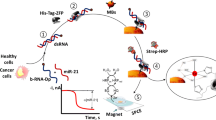Abstract
Solid-state molecular beacons show great potential for label-free biomarker detection, however, it is challenging to construct robust and homogenous quantum dot molecular beacon microarrays in a microfluidic platform. Here, we report a simple and cost-effective method of constructing a mercaptopropionic acid quantum dot (MPA-QD) microarray in a microfluidic platform using a PDMS through-hole structure. This method combines soft lithography and surface functionalization to achieve uniform QD immobilization in a microfluidic network. With the simple fabricated quantum dot microarray sensor integrated in the microfluidic device, label-free biomarker detection was performed with high efficiency, specificity and sensitivity. We performed cardiovascular biomarker detection, and our microfluidic QD molecular beacon platform achieved target DNA sequence identification at a low concentration of 1 nM/L.






Similar content being viewed by others
References
Algar WR, Krull UJ (2008) Quantum dots as donors in fluorescence resonance energy transfer for the bioanalysis of nucleic acids, proteins, and other biological molecules. Anal Bioanal Chem 391:1609–1618. doi:10.1007/s00216-007-1703-3
Cady NC, Strickland AD, Batt CA (2007) Optimized linkage and quenching strategies for quantum dot molecular beacons. Mol Cell Probes 21:116–124. doi:10.1016/j.mcp.2006.09.001
Chen AK, Tsourkas A (2009) Imaging RNA in living cells with molecular beacons: current perspectives and challenges. J Innov Opt Health Sci 2:315–324. doi:10.1142/s179354580900070x
Chen GH, Liu NK, Zhou AR, Tang CS, Ma DL, Tang J (2001) The role of hypertension-related gene in aortic vascular smooth muscle cells from mice and rats. Chin Med J 114:833–836
Clapp AR, Medintz IL, Fisher BR, Anderson GP, Mattoussi H (2005) Can luminescent quantum dots be efficient energy acceptors with organic dye donors? J Am Chem Soc 127:1242–1250. doi:10.1021/ja045676z
Culha M, Stokes DL, Griffin GD, Vo-Dinh T (2004) Screening for the breast cancer gene (BRCA1) using a biochip system and molecular beacon probes immobilized on solid surfaces. J Biomed Opt 9:439–443. doi:10.1117/1.1691025
Fang XH, Liu XJ, Schuster S, Tan WH (1999) Designing a novel molecular beacon for surface-immobilized DNA hybridization studies. J Am Chem Soc 121:2921–2922. doi:10.1021/ja9837809
Kang JH, Um E, Park J-K (2009) Fabrication of a poly(dimethylsiloxane) membrane with well-defined through-holes for three-dimensional microfluidic networks. J Micromech Microeng. doi:10.1088/0960-1317/19/4/045027
Kartalov EP, Walker C, Taylor CR, Anderson WF, Scherer A (2006) Microfluidic vias enable nested bioarrays and autoregulatory devices in Newtonian fluids. Proc Natl Acad Sci USA 103:12280–12284. doi:10.1073/pnas.0602890103
Li JWJ, Fang XH, Schuster SM, Tan WH (2000) Molecular beacons: A novel approach to detect protein–DNA interactions Angewandte Chemie-International Edition 39:1049- + doi:10.1002/(sici)1521-3773(20000317)39:6<1049::aid-anie1049>3.0.co;2-2
Li Y-Q et al (2011) Simultaneous detection of dual single-base mutations by capillary electrophoresis using quantum dot-molecular beacon probe. Biosens Bioelectron 26:2317–2322. doi:10.1016/j.bios.2010.10.002
Liu HW, Jing YY, Yu X, Pang DW, Zhang ZL (2012) Construction of CdSe/ZnS quantum dot microarray in a microfluidic chip. Sci China-Chem 55:543–549. doi:10.1007/s11426-012-4546-5
Mohammed M-I, Desmulliez MPY (2011) Lab-on-a-chip based immunosensor principles and technologies for the detection of cardiac biomarkers: a review. Lab Chip 11:569–595. doi:10.1039/c0lc00204f
Santangelo PJ, Nix B, Tsourkas A, Bao G (2004) Dual FRET molecular beacons for mRNA detection in living cells. Nucleic Acids Res. doi:10.1093/nar/gnh062
Tyagi S, Kramer FR (1996) Molecular beacons: probes that fluoresce upon hybridization. Nat Biotechnol 14:303–308. doi:10.1038/nbt0396-303
Wang CY, Zhang YL, Yang Q, Yang Y, Gu YP, Wang MC, Wu KY (2007) A novel cultured tissue model of rat aorta: VSMC proliferation mechanism in relationship to atherosclerosis. Exp Mol Pathol 83:453–458. doi:10.1016/j.yexmp.2007.08.002
Wang J, Onoshima D, Aki M, Okamoto Y, Kaji N, Tokeshi M, Baba Y (2011) Label-free detection of DNA-binding proteins based on microfluidic solid-state molecular beacon sensor. Anal Chem 83:3528–3532. doi:10.1021/ac200236r
Wu SM, Tian ZQ, Zhang ZL, Huang BH, Jiang P, Xie ZX, Pang DW (2010) Direct fluorescence in situ hybridization (FISH) in Escherichia coli with a target-specific quantum dot-based molecular beacon. Biosens Bioelectron 26:491–496. doi:10.1016/j.bios.2010.07.067
Acknowledgements
This work is supported by the National Natural Science Foundation of China (31570861 and 61306145), the Ministry of Science and Technology of China (2015AA020409), the Shenzhen Science and Technology Innovation Committee Grant (KQCX20140521115045445), the Major Program of Guangdong Science and Technology Project (2015B020227002), and the Guangdong Innovative Research Team Program (No. 2011S013) and its Shenzhen Supporting Fund (KYPT20121228160843693), and the Shenzhen Basic Science Fund (JCYJ20160331185602643).
Author information
Authors and Affiliations
Contributions
HL and YC conceived and designed the experiments. HL and WS performed the fabrication and the experiments. HF optimized the fabrication process. BZ and ZL analyzed the measurement data, and YC organized the paper. All authors were involved in the preparation of this manuscript.
Corresponding author
Ethics declarations
Conflict of interest
The authors declare no conflict of interest.
Additional information
This article is part of the topical collection “2016 International Conference of Microfluidics, Nanofluidics and Lab-on-a-Chip, Dalian, China” guest edited by Chun Yang, Carolyn Ren and Xiangchun Xuan.
Rights and permissions
About this article
Cite this article
Liu, H., Shu, W., Liu, Z. et al. A simple method of constructing microfluidic solid-state quantum dot molecular beacon array for label-free DNA detection. Microfluid Nanofluid 21, 67 (2017). https://doi.org/10.1007/s10404-017-1906-7
Received:
Accepted:
Published:
DOI: https://doi.org/10.1007/s10404-017-1906-7




